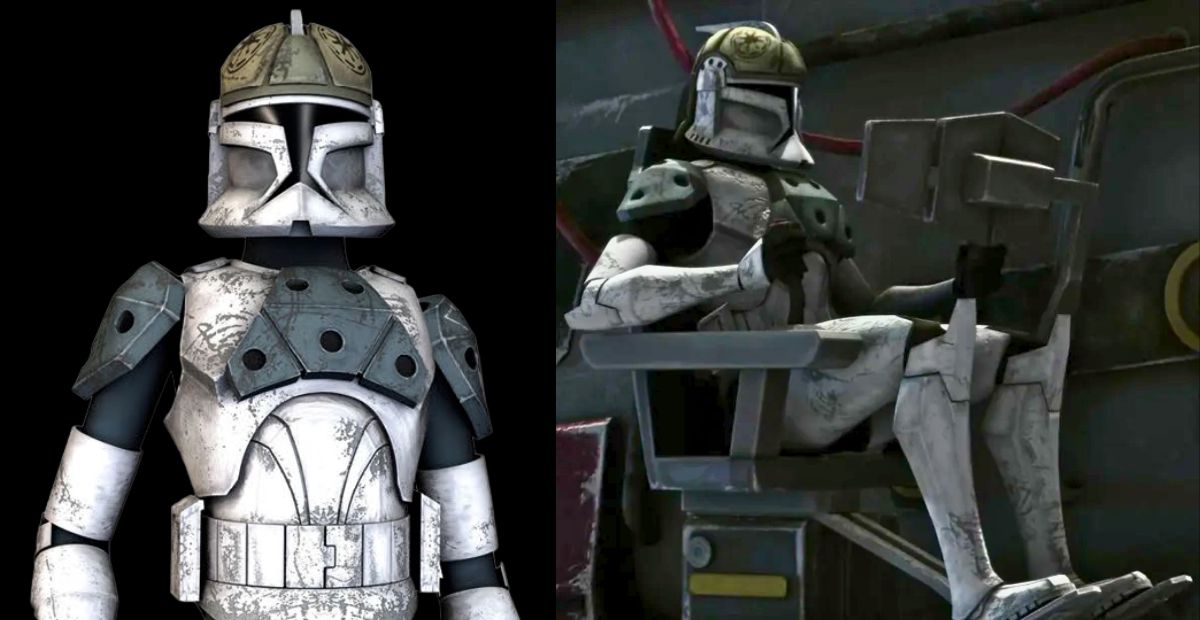Clone armor is designed to be durable, efficient, and iconic. Most troopers march into battle looking sharp, even if their armor’s a bit scratched from the field. But then there are the clone gunners — the ones manning the AV-7 cannons or perched on top of AT-TEs. Their armor? Caked in soot. Smoke-streaked. Dust-blasted to the point you can barely see the white underneath.
It’s not a mistake, and it’s not laziness. The battlefield does that to them—fast. So why exactly do clone gunners look so rough compared to everyone else?
Gunners Operate Out in the Open, So the Battlefield Paints Their Armor
Ground-based clone gunners aren’t tucked inside cozy cockpits; they’re basically hugging the cannon out in the elements. Take the AV-7 antivehicle cannon you see in “Landing at Point Rain” and “Weapons Factory.” Once its repulsorlift legs plant, the operator works a waist-high console bolted to the barrel’s side, kneeling or standing right beside the breech while each round coughs hot propellant, oily vapor, and metal dust straight into the Clone’s chest plate.
It’s just as bad up on an AT-TE. The walker’s mass-driver cannon sits in an open rooftop turret, so the clone cranking the elevation wheel is riding shotgun in full view of the battlefield, sheltered only by a knee-high blast screen. Every salvo shrouds him in smoky exhaust and whatever grit the shockwave kicks skyward—watch the Umbara or Geonosis arcs and you’ll see those gunners literally disappear in clouds of orange dust and spent propellant.
Only the clones manning turbolasers deep inside a Venator’s armored hull work from enclosed stations, and The Clone Wars rarely follows them because open-field artillery makes for better spectacle. So the dirt and scuffs you notice aren’t a continuity slip—they’re a badge of the job. Most clone gunners spend an entire firefight perched on exposed gun carriages or walk-top turrets, where every boom slaps a fresh layer of soot onto that bright-white plastoid. Real tank crews will tell you the same thing: after a day behind a big gun, you’re caked in grime from helmet to boots—and on clones, every stain shows.
Dust-Bowl Battlefields Sandblast Their Armor in Minutes
If you’ve re-watched the Geonosis arc lately, you’ll know exactly what I’m talking about. Those AV-7 cannons roll in, drop their repulsor legs, and every shot sends a fresh burst of scorched orange sand straight back over the crew.
Geonosis isn’t the only offender, either. Christophsis has glass-dust whipping around like sleet, and Umbara’s air is thick with black ash. Stick an open-turret gunner in that mess and the results are predictable: pitted shoulder bells, smoke-striped chest plates, and helmets dull enough to blend with the dirt. You could buff your armor shiny on the Venator, but the first salvo planetside will sandblast it to a charcoal finish. That’s not a continuity glitch—that’s just what happens when you bolt a cannon onto a walker roof and park it in the galaxy’s worst dust storm.
Gunner Armor Is Built to Take the Hit
Here’s another reason those cannon crews never sparkle: their armor isn’t meant to look good, it’s meant to keep them standing after a recoil shock. According to Wookieepedia, gunner kits kept the regular Phase I/II shell but swapped in heavier composite plates across the chest and lower back, plus extra noise-baffling layers inside the helmet so the trooper’s ears didn’t ring after every blast. All that extra material traps grime in every crack and seam, and it weighs a lot more than parade-gloss plastic, so crews skip the full polish just to save time and energy between missions.
Now add the fact that artillery units bounce from one hotspot to the next with barely a pit stop. There’s no luxury “clean-and-paint” cycle waiting back on the Venator—by the time a gunner scrubs off one layer of soot, the next fire mission is already loading shells. So the stains stick, the dings pile up, and the battered finish turns into a badge of the trade.

